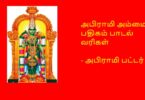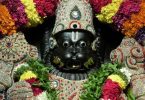Raksha bandhan
Raksha Bandhan stirs up one of the deepest emotions in people the steadfast and chaste bond of love between the brother and the sister. Raksha means to protect and Bandhan means binding, hence signifying the sister tying the Rakhi around her brothers wrist as a symbol of love and a bond of protection. This love and protection is mutual and not just one-sided, as is stereotypically believed.
Origins
There are many origins of Raksha Bandhan which narrate the tying of the Rakhi as a bond of protection. However, the sister-brother relationship highlighted by the Rakhi goes far beyond the protection of the sister from her brother. It implies the basic element of a cordial life where all members of society look upon themselves as brothers and sisters:
|| Vasudhaiva Kutumbakum The Whole World is One Family ||
(Mahopanishad VI.71-73)
Other narratives of Raksha Bandhan are:
The Rakhi between Indra and his wife Indrani
The Bhavishya Purana recites the battle between the Devas (Gods) and the Daanavas (Demons) which lasted twelve years. The Devas, including the mighty Indra were defeated. As they prepared to fight again, Indrani tied a Rakhi on her consort Indra, and Indra won the battle, thus extolling the significance and glory of Raksha Bandhan. The feminine is often given the association of shakti (power) in Hindu thought, and with the strength of the females, the males prosper. On this occasion, the Rakhi is given by a wife to her husband.
Kunti blesses her Grandson
During the battle of the Mahabharata, Queen Kunti tied a Raksha on her grandson Abhimanyu to protect him in battle. Raksha Bandhan does not necessarily have to be celebrated between a sister and a brother and can be tied between any two people who have a deep bond. To this day, often when a young Hindu leaves the home for long periods for work, a Rakhi is tied to remind them of what they have left behind and should return for.
The story of King Bali and Lakshmi
When Lord Vamandev was pleased with King Bali and appeared as Vishnu as the fifth avatar (incarnation), Bali asked a boon that Lord Vishnu would leave His abode Vaikunth and come to Patalaloka, King Balis kingdom. Lord Vishnu agreed and became a Dwarpalaka (guard) of Bali standing outside the door. When this news reached Goddess Lakshmi via Narada, She was greatly distressed.
In order to make Her husband return, Lakshmi went to Bali as a poor woman seeking help on the day of Shravana Purnima. She told Bali that She didnt have a brother and would dearly like one. Bali agreed that from now on he would be Her brother and She accepted him as her brother by tying a Raksha on him. He told Her to ask him for anything She needs, and She requested Lord Narayans return. She grieved that despite having a consort She was experiencing premature widowhood in Narayans absence. However, the Lord had pledged to eternally protect Bali, by guarding his door.
To resolve his dilemma, Brahma and Shiva agreed to guard Bali for four months each, while Vishnu (Narayan) would guard him for the auspicious four months- Chaturmaas beginning from Ashadh Sud Ekadashi and terminating on Kartik Sud Ekadashi, usually from Mid-July to Mid-November.
Therefore when Brahmin priests perform puja rituals, they chant a famous mantra while tying the nada chhadi (raksha) on a devotee:
||Yena baddho Baliraja daanavendro Mahaabala
tena twaamabhi badh naami rakshe maa chala maa chala||
I tie onto you (the devotee) the raksha which was tied on Bali, the King of demons. Therefore, O Raksha! Do not ever fail to protect this devotee, do not ever fail.
Rituals
On the day of Raksha Bandhan, the sister will visit the home of her brother and performs his pujan by applying kumkum and rice grains on his forehead. She would then fasten a Rakhi to her brother as a symbol of love and a bond of protection. She will also offer him mithai (sweets). In return, the brother bestows upon her a gift and vows to protect her.
Adorning Yagnopavit
On this day, Yajurvedi and Rigvedi Brahmins and those who normally wear yagnopavit (janoi) also adorn new janois.
Birth of Balabhadra
This day is also celebrated as the birth of Lord Balaram, also called Balabhadra. He is the elder brother of Shri Krishna and is considered an incarnation of Ananta Shesh, the great serpent upon which Lord Vishnu rests. To save the child from the tyranny of Kamsa who had vowed to kill all of Devakis offspring, the child was transferred into the womb of Rohini, another of Vasudevas wives who resided safely in Gokul. Bhagavans elder brother is well known for his wisdom and phenomenal strength.
Tying a Rakhi to the communal deity and to each other
There are many Hindu communities where the members would tie a Rakhi to each other and to the deity or Guru. The tying of the Rakhi to each other in the community regardless of the social background and status of the persons taking part shows the equality between the community and their tying it to the deity represents their personal relationship to God. This concept is far more comprehensive than the concept of the maximum happiness of the maximum number.
In fact, spontaneous love and compassionate service for the poor and lowly in society is regarded as the highest form of worship of God Himself. The spirit of selfless social service, protection of mankind and help given to the needy is thus transformed into a sadhana (spiritual practice). Hence, Raksha Bandhan represents a most auspicious occasion to recharge ourselves every year with the true spirit of protection, service and sacrifice for the welfare of society, and find therein the highest spiritual fulfilment of human life.





